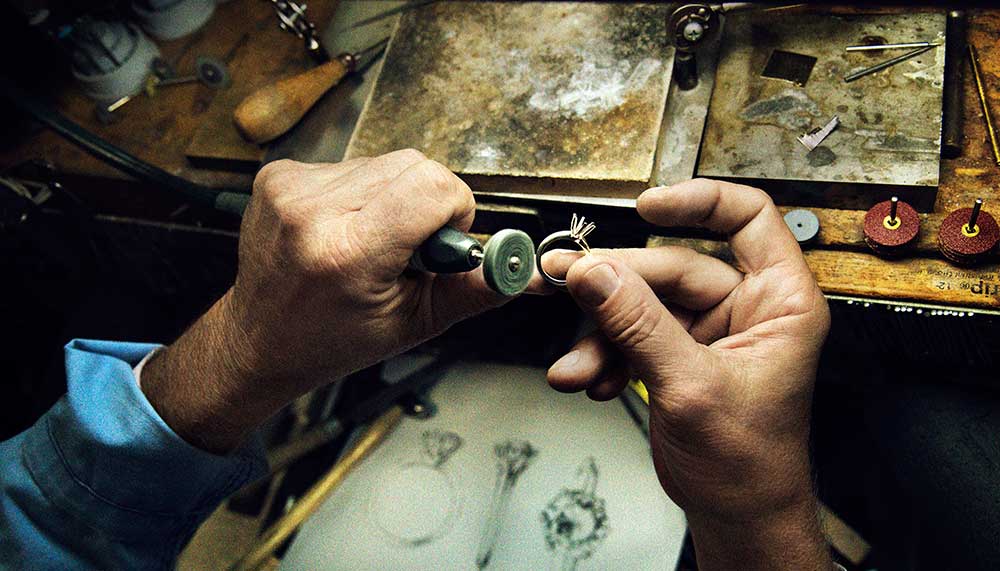Rise and Shine
You know you’ve arrived when you get your own emoji. Fans of the popular ideogram will recognise the inspiration behind the solitaire diamond engagement ring, complete with six-pronged setting and a gemstone in a familiar shade of blue.

It may have found a new lease on life in social media, but the famed Tiffany setting boasts a storied history that dates back to 1886. Engagement rings at the time were set in bezels close to the band, surrounding the diamond with ornate engravings and embellishments that partially obscured the main attraction. Charles Lewis Tiffany lifted the stone off the band via six platinum prongs, thereby maximising the light reflected from each facet. He also daringly left the metal unadorned, allowing the diamond to take centre stage. As a final flourish, Tiffany named the setting after himself, so confident was he in its potential to succeed.
Today, the Tiffany setting has become the de facto setting for solitaire engagement rings and remains the company’s most popular engagement ring. However, while the term Tiffany setting may have become part of common parlance, it is far from common. The jewellery giant recently won a landmark lawsuit against American warehouse club chain Costco for using the word ‘Tiffany’ as a generic description for its ring settings, and launched an ad campaign this year that showcases the highly skilled craftspeople behind its coveted engagement rings. Created to commemorate the Tiffany setting’s 130th anniversary, the ‘I Will’ campaign turns the spotlight on its top gemologists and artisans, emphasising the ultra-exacting standards that go into the creation of each ring. Playing a prominent role in the series is Melvyn Kirtley, Tiffany’s chief gemologist, who is shown intensely scrutinising a ring through his loupe while declaring that he will “reject 99.96 per cent of the world’s finest diamonds because there’s a difference between quality and Tiffany quality”.
Key to this Tiffany quality is how the brand assesses its diamonds beyond the 4Cs. Each diamond should possess a distinctive brilliance – describing how well the craftsman has cut the facets, removed flaws and brought out a gem’s scintillating light. On top of this, the brand also assesses each stone for a more intangible quality, which it terms “presence”, or “the combination of all these qualities coming together as one,” says Kirtley.
While the temptation to cut a stone for maximum weight is continuously present, it’s one that Tiffany has always resisted. Instead, its craftsmen cut for beauty, following a practice that prominent jeweller and gemologist Frederic Kunz pioneered in 1886, says Andrew Hart, senior vice president, diamonds and gemstones. “We have a specific set of standards in terms of the proportions of a diamond: how big the table should be, how high the crown, how deep the pavilion. Each facet has to be completely smooth, with an adamantine lustre. All the facet junctions have to line up and point exactly right. There cannot be any nicks, scratches or defects of any kind,” says Hart.

Each diamond’s 57 facets is polished to perfection before the craftsman moves on to the next. This meticulous approach is sacrosanct to Tiffany, and is applied to all of its diamonds, regardless of whether its craftsman is dealing with a record-breaking rock or an accent diamond of less than a millimetre in diameter.
This ‘micro’ approach to managing every aspect of its creations is one that Tiffany extends to its entire production process, sourcing its diamonds directly from mines and enforcing a strict code of corporate social responsibility among its suppliers. Despite its global network, much of the brand’s jewellery remains proudly American-made. According to Hart, Tiffany sources its gold and platinum from large mines in the US, particularly from Montana’s famed Stillwater Mine. It also crafts the mountings for its diamonds in its factory on Rhode Island, a few hours away from Manhattan.
Unlike other brands, Tiffany uses its own grading lab, and every purchase of a Tiffany setting comes with its own Tiffany Diamond Certificate and a Lifetime Warranty, a testament of quality that has resonated well with its courting customers. On average, 30 proposals of the bended-knee variety take place every year at the brand’s Fifth Avenue flagship in New York, proof that the best place to seal the deal goes beyond a tropical seaside or extravagant restaurant. In celebration of its anniversary, Tiffany will debut two new designs – one in rose gold and a Limited Anniversary Edition Pave version with platinum band and prongs set with pave diamonds.
Ultimately every Tiffany ring is a glittering microcosm of love itself – time and pure effort, coupled with a good dose of fortuitous chance.
“The whole process of creating a Tiffany engagement ring takes about a year, not that much compared to the three billion years it takes for nature to produce a diamond,” says Hart, adding that every ring is unique because every diamond is different. “Rough diamonds tell you what they want to become.”









